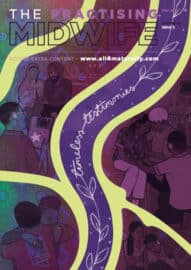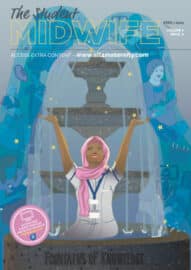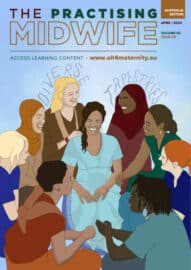Playing Kate: Re-staging maternal transformation
A guest blog by Jodie Hawkes
Introduction
Since 2005 I have been making performances with my partner Pete Phillips as part of a live art duo Search Party. One of our theatre performances, My Son and Heir (2015) was made shortly after the birth of our first son Edward, which coincided with the birth of Prince George, the Duke and Duchess of Cambridge’s first baby. After Edward’s birth, surrounded by a sea of plastic toys, heavily sleep deprived I sat on the sofa, despairing, whilst watching the relentless daily TV coverage of the royal birth. My Son & Heir is a theatre performance that considers the possibilities of what sort of man our own baby son (and heir…?) will become.
Making My Son & Heir I did my mothering, whilst Kate did hers, both attending to our sons, but in very different worlds. I queued up in the pound shop, went to the park, pushed the pram around Cameron’s ‘broken Britain’, wrestled with the rain cover, did the supermarket shop and posed for family portraits in the garden of our two-bed mid-terrace (rented) palace, all whilst dressed as a costume-party version of the newest royal mother. These performances of my own mothering in the guise of the Duchess of Cambridge became another performance project, Playing Kate (2014).
Playing Kate
Staging normality
Middleton is represented as part of a celebrity motherhood culture that reinforce notions of thrift, the retreat into the domestic and the respectable maternal body (Allen et al., 2015). Through a process of ‘normalisation’ (Clancy, 2015), Middleton becomes the embodiment of neoliberal aspiration and a living manifestation of austerity rhetoric of equality and togetherness.
In her official public appearances, Middleton (with her baby) – wittingly or unwittingly – stages her ‘normality’ as a means of obscuring the privilege of her lived reality. Playing Kate attempts to reconfigure this relationship through a series of performative actions that deliberately clashes these two normals – the staged ‘normality’ of Middleton and the daily-lived experience of my own mothering. Through the performative reconfiguration of my own maternal experience through the lens of Kate’s ‘normal’, I make my own mothering visible.
Kate and Will stepping out of the Lindo Wing with Prince George is an iconic moment in the history of the new royals, a key moment I restaged as I left the hospital after having my third child, Jude.
In this project Playing Kate: Outside the hospital (2017) I explore a series of transformations (Baraitser, 2006), the transformation from womanhood to motherhood, my performative transformation from Jodie to fake-Kate, Kate’s maternal transformation from commoner, to royalty, to producer of an heir, the media’s (non)transformation of Kate as she emerges seamlessly as (good) mother, Kate’s post-birth-trauma-feminine-makeover transformation, and the neoliberal aspirational transformation, the inducement to be just like Kate.
The hospital doors – a transformative threshold
I am interested in the moment of maternal transformation that might be happening when a mother leaves the hospital. Where she might appear outside of the care and security and privacy of the hospital (if that is even possible when we consider the very public nature of an NHS maternity ward) and out into the world, or in my instance the concrete carpark.
I wonder what sort of transforming is happening when the mother leaves the hospital and enters a more public sphere, where the mother reveals herself for the first time, as something different from when she was last seen going in. The electric doors acting as a kind of transformative magic threshold.
The hospital doors are a strange place, the only images of ‘real’ women we see outside the hospital are grainy CCTV stills of mothers in trouble. In 2009 I left St Michael’s hospital in Bristol with my first child, my baby daughter Ruby, through the same hospital doors that a few years later, Charlotte Bevan (a mother in trouble) and her 4 day old daughter, are seen on grainy CCTV images, leaving the hospital, walking, only in slippers in freezing conditions, unnoticed, tragically on her way to the Clifton Suspension bridge.
Performances – nothing has changed
Whilst there’s little trace of most mothers, perhaps one could argue that the moment the mother leaves the hospital is as seminal as the moment of giving birth itself.
Whilst the media camp out for two weeks to get pole position to photograph the new royals, images of Kate arriving at the hospital in labour are never seen. Her actual entrance into the hospital is hidden, her arrival marked by rumor, hearsay and short carefully constructed press releases. And so the photographers continue to wait, as we do, only hearing about the labour as ‘progressing normally’.
For Kate any discomfort or difficulty is kept private, unspoken, hidden, any trace erased. We never hear the royal birth story, the sort women share at playgroups and when their own children have children. We never hear about the midwives, led by Jaquie Dunkley-Bent; their labour in this royal history is invisible. When we do see Kate appear from the private suite of the Lindo wing, she miraculously appears and in the performance of Kate nothing has changed.

In recreating the image of Kate, I return to the hospital to restage the moment I exited with my baby. In my performance as Kate hospital staff and expectant mothers smile awkwardly at the uncanny costume, a subtle rupture of the status quo.
The performance in the ‘official’ space of the hospital feels quietly problematic or challenging, here I am with my baby doing something ‘normal’, standing, waiting, walking, that feels very ‘other’. Whilst I am re-staging these images of Kate I am also doing my mothering, my real maternal choices on stage for passers-by to see. At one moment I stand in the road so as to get the perfect shot, an odd mother in the road with a young baby acting suspiciously. And there, stood in the road holding the baby perhaps I reveal a different mother. The mother as trouble maker. A quiet type of maternal activism.
Whilst Middleton and the new Royals attempt to appear just like us, here I am outside the hospital performing just like her, as she tries to perform just like me.
A guest blog by Jodie Hawkes
http://searchpartyperformance.org.uk
@search_party












